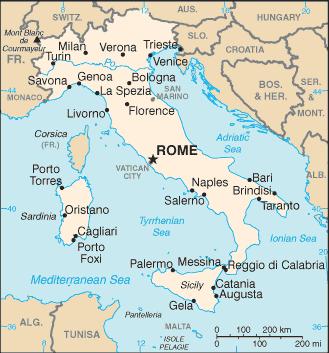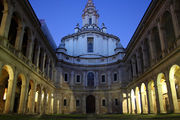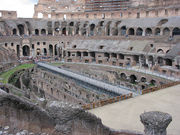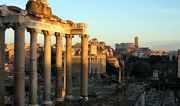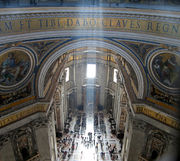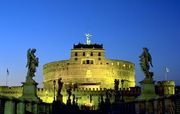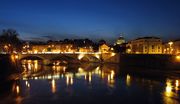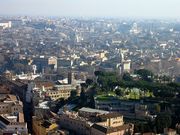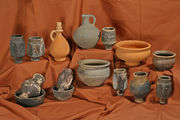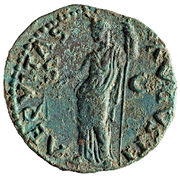Rome
| Name::Rome Native name::'''''Roma''''' | |||
|
The Colosseum | |||
| |||
| Nickname(s): Nickname::Eternal City | |||
| Motto: Motto::''Senatus populusque Romanus'' | |||
|
Location of Rome in Italy | |||
| Coordinates | Coordinates::41°54'00"N; 12°30'00"E | ||
|---|---|---|---|
| Country | Country::Italy | ||
| Province | Province::Lazio | ||
| Founded | Founded::April 21, 753 BC | ||
| Founder | Founder::Romulus | ||
| Named for | Namesake::Romulus | ||
| Government | |||
| - Type | Government type::Mayor-council | ||
| - Mayor | Mayor::Walter Veltroni | ||
| Area | |||
| - City | City area::1285 km² | ||
| Highest elevation | Maximum elevation::120 m | ||
| Lowest elevation | Minimum elevation::13 m | ||
| Population | |||
| - City | 2,500,000 | ||
| - Density | Population density::1945.525 km⁻² | ||
| Time zone | Time zone::CET (UTCTime offset::+2) | ||
| - Summer (DST) | Time zone summer::CEST (UTCTime offset summer::+3) | ||
Rome (Latin and Italian: Roma) is the capital of modern Italy, as well as the former capital of the ancient Roman Empire. Rome is traditionally said to have been founded on Founded::April 21, 753 BC, and is sometimes called "the eternal city." Holding over 2.5 million residents, Rome is Italy's largest and most populous commune. It is also Italy's third largest metropolitan area following Milan and Naples.
Geography
Rome is located in the Lazio region of central Italy, bordered by Tuscany, Umbria, Abruzzi, Marche, Molise, Campania and the Tyrrhenian Sea. Rome's altitude ranges from 13 meters above sea level to 120 meters above sea level at the top of Monte Mario. Rome covers and area of about 1,285 square kilometers.
Rome has a Mediterranean climate. Most regions with Mediterranean climates have calm winters. Summer temperatures are variable, depending on the region. The average high temperature during December is 57° F. During August, the temperature is usually around 90° F. April through June, and mid-September through October is when Rome experiences its most enjoyable weather.
History
Ancient Rome
The Roman Kingdom
The Roman Kingdom (Latin: REGNVM·ROMANVM) was led by a succession of seven kings. Legends envelop Rome's founding and early history. There are many theories that endeavor to explain Rome's birth. The more popular theories include the theory/legend that Rome was established by the twins Romulus and Remus on April 21, 753 BC. Romulus and Remus were supposedly the sons of the Roman god of war, Mars. The most widely accepted theory of Rome's commencement is supported by archaeological evidence. This theory suggests that Rome grew from small rural settlements on the Palatine Hill and in the area of the future Roman Forum, assembling into a city in the 8th Century BC. Romulus was the first king of Rome in the line of "the seven legendary kings". The kingdom came to an end with the dismissal of Lucius Tarquinius Superbus, the seventh legendary king of Rome, in 510 BC, followed by the the formation of the Roman Republic.
The Roman Republic
- Main Article: Roman Republic
The Roman Republic (Latin: RES·PVBLICA·ROMANORVM) was the representative government of Rome and its territories from 510 BC until the establishment of the Roman Empire, sometimes placed at 44 BC (the year of Caesar's appointment as perpetual dictator) or, more commonly, 27 BC (the year that the Roman Senate granted Octavianus the title "Augustus").
The Roman Republic was governed by a senate. The republican period generated with the overthrow of the Monarchy in 509 BC when a series of civil wars led the republic into the Principate government and propelled Rome into the Imperial period.
The Roman Republic was a stage in ancient Roman civilization that was defined by a republican form of government. As Rome came out of the republic, it grew into an empire. It is not precisely known what event or events fueled the ascension into the empire. Many historians believe that it was the result of two main events. First was the ordainment of Julius Caesar as dictator. The second turning point was the Battle of Actium—the main battle in the Roman civil war between those who followed Octavian and those who followed Mark Antony.
The Roman Empire
- Main Article: Roman Empire
The Roman Empire (Latin: IMPERIVM·ROMANVM) was ruled by emperors. It followed the Roman Republic, which lasted almost 500 years. The empire was defined by autocratic (a ruler having unlimited power; a despot) government. Beginning from the rule of Augustus to the Fall of the Western Empire, Rome controlled much Europe, the Middle East, and Northern Africa and consequently made up the majority of the population. Rome had started gaining territory long before it became an empire. At the peak of expansion (as seen to the left), Rome controlled 2,300,000 square miles of land. Roman culture, including arts, architecture, theater, religion, government, and military had much influence, and continues to have influence today. Caesar Augustus was the most notable and famed leader of the Roman Empire. Rome was smooth to rule in time of peace, though there were occasional rebellions. Rebellions were not particularly hard to deal with, and were quelled in a matter of time.
Modern Rome
Rome was the largest city in the world (and most likely the largest city that was ever built) until the 19th Century. At the peak population, estimates range from 450,000 to over 3.5 million people, and estimates of 1 to 2 million at the time of Emperor Augustus. In 756, Pepin the Short appointed the Pope temporary authority over Rome and its surrounding areas. The Pope thus created the Papal States. Rome was the capital of the Papal States until it was annexed into the Kingdom of Italy in 1870. Rome became a major pilgrimage site during the Middle Ages. It also became the focus of conflict between the Papacy and the Holy Roman Empire starting with Charlemagne. Charlemagne was crowned its first emperor in Rome on Christmas Day 800, by Pope Leo III.
Rome retained its status of Papal capital and holy city for centuries to come. The city expanded as a hub of cultural activity during the Renaissance and the Baroque periods. Population again began to rise, reaching 100,000 during the 17th Century. After some conflict, French protection was removed in 1870, royal troops retook the city, and Rome was declared capital of the newly unified Italy in 1871. Rome was one of the victorious cities following World War I. Afterwards, it saw a rise of Italian Fascism. Benito Mussolini marched into Rome in 1922, and declared a new Empire and then allied Italy with Nazi Germany. During this period, Rome saw rapid growth in population. The population rose from 212,000 to over 1 million. This sharp rise was ended by World War II, as Rome was pounded by the Allied forces. After World War II, Mussolini was executed and a 1946 referendum abolished the monarchy, and replaced it with the Italian Republic.
Rome grew again greatly after the war, and the rising population continued until the mid-1980's, and now holds over 2,800,000 residents. Population is currently slowly declining, which is attributed to pollution. Walter Veltroni is the current Mayor of Rome. Rome has often been involved in the process of European political integration. The city hosted the signing of the treaty of Rome in 1957. This treaty established the European Economic Community (forerunner to the European Union). Rome hosted the official signing of the European constitution in July 2004. Rome is also the capital of important international organizations. One of these is the Food and Agriculture Organization of the United Nations. Rome is also where the Rome Statute of the International Criminal Court was concocted.
Modern day Rome has an active and assorted economic system. Rome's economy includes blossoming technologies, service sectors, and communications. It creates 6.7% of the national GDP, which is more than any city in Italy. Rome continues to grow by 4.4% annually, a higher rate than any city in the rest of the country.
Biblical Records
- Saint Luke records (Luke 2:1-2) that Augustus took a major census in the year when Quirinius was "in charge" of Syria Province. This Quirinius was probably Publius Sulpicius Quirinius. Under the procedures of the census, everyone needed to return to the city of his ancestors in order to enroll. Joseph of Nazareth and his wife Mary traveled to Bethlehem to enroll—and while they were there, Jesus Christ was born.
- According to the Bible, Saint Peter and Saint Paul were martyred in the city during the 1st Century.
Religion
Early Roman Religion
- Main Article: Polytheism
Ancient Roman religion fused many different cult practices and used more than a single set of beliefs. The original and most prominent early beliefs were animism and mythology.
Polytheism was widely accepted and practiced during Rome's early history. Leaders looked to the gods for guidance and wisdom. Many men and women dedicated their lives to serving these gods in their temples.
Vatican City
- Main Articles: Vatican City, Catholic Church
Rome surrounds Vatican City. Vatican City is a landlocked sovereign city-state. Its territory consists of a walled sanctuary, all of which is within the city of Rome. The Vatican City is around 108.7 acres, making it the smallest independent nation in the world. Vatican City was established in 1929 by the Lateran Treaty. It was created as a remnant of the Papal States. The city is an elected monarchy that is ruled by the Pope. Apostolic Palace is the Pope's official abode. The Pope is the chief of the state. Legislative authority is put in a commission of cardinals who are all appointed by the Pope. These cardinals are elected for five-year periods. Executive power lies with the President of that commission. He is assisted by the Deputy General Deputy General and General Secretary. Foreign relations are assigned to the Secretariat of State.
Mythology
- Main Article: Roman mythology
The city of Rome, which eventually became the hub of all things Roman, is saturated with mythology even from its very inception in which historians place around 750 BC. According to Roman mythology the god Mars and the priestess Rhea Silvia bore twin sons named Romulus and Remus.
The city of Rome was saturated with mythology even from its very inception. Roman mythology is largely based on the belief in or worship of multiple gods or deities, which is known as Polytheism.
Polytheism was widely accepted and practiced during Rome's early history. Leaders looked to the gods for guidance and wisdom. Many men and women dedicated their lives to serving these gods in their temples. The word comes from the Greek words poly theoi, meaning "many gods." In polytheistic belief, gods are perceived as complex beings of greater or lesser status, with individual skills, needs, desires and histories. These gods are not seen as being omnipotent, but rather human-like, having specific skills and abilities.
Christianity vs. Polytheism
The doctrine of the Trinity in Christianity is strictly monotheistic. Monotheism is belief in the existence of one deity or God, or in the oneness of God. The Trinity has been falsely denounced and labeled as polytheism in Islam and Unitarianism.
During Rome's history, it has persecuted Christians many times. The final and greatest persecution of Christians by the hand of the Roman Empire began in 303. Diocletian, the emperor that brought Rome out of the Crisis of the 3rd Century, was an ardent pagan. He became concerned about the growing number of Christians in the Empire. He persecuted Christians with zeal not known since the rule of Nero; resulting in one of the greatest Christian persecutions in history. In 311, Galerius ended the persecution of Christians and declared Christianity legal in 313. In 380, Emperor Theodosius I announced Christianity as the official religion of the Roman Empire in allowing it to spread even further. As Christianity spread, the Bishop of Rome was appointed, and would later come to be known as the Pope. The pope claimed authority over all Bishops and also all Christians. This was placed on the basis that he himself is the successor of Saint Peter, upon whom Jesus Christ built His Church. More currently, the Islamic community has and continues to grow significantly. This is mainly due to immigration from North African and Middle Eastern countries into the city. As a result of this growth, the commune promoted the building of the largest mosque in Europe.
Archaeology
- Main Article: Archaeology
The Roman Forum
Some remains of paving indicate that sediment that had eroded from the surrounding hills was already raising the level of the forum in early Republican times. A temporary excavation began in the late 18th Century. Carlo Fea began clearing the debris from the Arch of Septimius Severus in 1803, and archaeologists during the the Napoleonic period marked the beginning of clearing the Forum. The Forum was completely excavated during the early 20th Century. Remains from several centuries are currently shown together, due to the Roman practice of building over earlier ruins. The hill seen in the background of the above picture is Palantine Hill. It is believed that the Roman Forum started growing from rural settlements on Palantine Hill.
The Colosseum
- Main Article: Colosseum
The Colosseum was (and still is) a massive amphitheatre in the center of Rome. It has been the center of attraction throughout Rome's history, including today as it is a major tourist attraction. Thousands of tourists pay to view the interior arena each year. The Colosseum was used to present gladiatorial shows as well as a variety of other events. Gladiators were pitted against seemingly unbeatable foes such as; rhinoceros, hippos, elephants, giraffes, lions, panthers, leopards, crocodiles and ostriches, as well as fellow men. The Colosseum was probably capable of accommodating 87,000 people. The Colosseum is 157 ft high, 615 ft long, and 510 ft wide.
Welwyn Roman Baths
The Welwyn Roman baths are a small portion of the Dicket Mead villa. Dicket Mead villa is a Roman ruin that was built in the 3rd Century AD just north of modern-day Welwyn, Hertfordshire. Local archaeologist Tony Rook uncovered the ruins in 1960. The baths were gradually uncovered over the next 10 years by excavation. The Dicket Mead villa was probably part of a farm.
Gallery
See Also
 Browse |
 Browse |
References
- Ancient Rome www.crystalinks.com
- Rome Wikipedia
| |||||||||||||||||||||||
| ||||||||||||||||||||



